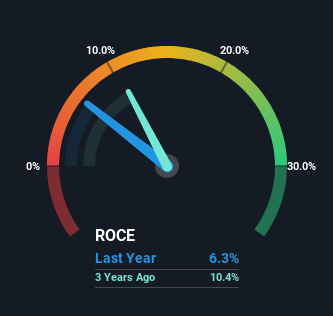- China
- /
- Medical Equipment
- /
- SHSE:688580
Nanjing Vishee Medical Technology (SHSE:688580) Is Reinvesting At Lower Rates Of Return

Did you know there are some financial metrics that can provide clues of a potential multi-bagger? Ideally, a business will show two trends; firstly a growing return on capital employed (ROCE) and secondly, an increasing amount of capital employed. Basically this means that a company has profitable initiatives that it can continue to reinvest in, which is a trait of a compounding machine. Having said that, from a first glance at Nanjing Vishee Medical Technology (SHSE:688580) we aren't jumping out of our chairs at how returns are trending, but let's have a deeper look.
What Is Return On Capital Employed (ROCE)?
For those who don't know, ROCE is a measure of a company's yearly pre-tax profit (its return), relative to the capital employed in the business. To calculate this metric for Nanjing Vishee Medical Technology, this is the formula:
Return on Capital Employed = Earnings Before Interest and Tax (EBIT) ÷ (Total Assets - Current Liabilities)
0.063 = CN¥106m ÷ (CN¥1.8b - CN¥116m) (Based on the trailing twelve months to March 2024).
Therefore, Nanjing Vishee Medical Technology has an ROCE of 6.3%. On its own that's a low return on capital but it's in line with the industry's average returns of 6.4%.
View our latest analysis for Nanjing Vishee Medical Technology

Above you can see how the current ROCE for Nanjing Vishee Medical Technology compares to its prior returns on capital, but there's only so much you can tell from the past. If you're interested, you can view the analysts predictions in our free analyst report for Nanjing Vishee Medical Technology .
So How Is Nanjing Vishee Medical Technology's ROCE Trending?
On the surface, the trend of ROCE at Nanjing Vishee Medical Technology doesn't inspire confidence. Over the last five years, returns on capital have decreased to 6.3% from 34% five years ago. Although, given both revenue and the amount of assets employed in the business have increased, it could suggest the company is investing in growth, and the extra capital has led to a short-term reduction in ROCE. If these investments prove successful, this can bode very well for long term stock performance.
On a related note, Nanjing Vishee Medical Technology has decreased its current liabilities to 6.5% of total assets. That could partly explain why the ROCE has dropped. What's more, this can reduce some aspects of risk to the business because now the company's suppliers or short-term creditors are funding less of its operations. Some would claim this reduces the business' efficiency at generating ROCE since it is now funding more of the operations with its own money.
The Key Takeaway
Even though returns on capital have fallen in the short term, we find it promising that revenue and capital employed have both increased for Nanjing Vishee Medical Technology. However, despite the promising trends, the stock has fallen 70% over the last three years, so there might be an opportunity here for astute investors. As a result, we'd recommend researching this stock further to uncover what other fundamentals of the business can show us.
On a final note, we found 2 warning signs for Nanjing Vishee Medical Technology (1 can't be ignored) you should be aware of.
For those who like to invest in solid companies, check out this free list of companies with solid balance sheets and high returns on equity.
Valuation is complex, but we're here to simplify it.
Discover if Nanjing Vishee Medical Technology might be undervalued or overvalued with our detailed analysis, featuring fair value estimates, potential risks, dividends, insider trades, and its financial condition.
Access Free AnalysisHave feedback on this article? Concerned about the content? Get in touch with us directly. Alternatively, email editorial-team (at) simplywallst.com.
This article by Simply Wall St is general in nature. We provide commentary based on historical data and analyst forecasts only using an unbiased methodology and our articles are not intended to be financial advice. It does not constitute a recommendation to buy or sell any stock, and does not take account of your objectives, or your financial situation. We aim to bring you long-term focused analysis driven by fundamental data. Note that our analysis may not factor in the latest price-sensitive company announcements or qualitative material. Simply Wall St has no position in any stocks mentioned.
About SHSE:688580
Nanjing Vishee Medical Technology
Engages in the research, development, production, and sale of medical devices in China.
Flawless balance sheet with limited growth.
Similar Companies
Market Insights
Community Narratives



